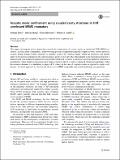| dc.contributor.author | Erbes, Andreja | |
| dc.contributor.author | Wang, Wentao | |
| dc.contributor.author | Weinstein, Dana | |
| dc.contributor.author | Seshia, Ashwin A | |
| dc.date.accessioned | 2021-09-20T17:30:21Z | |
| dc.date.available | 2021-09-20T17:30:21Z | |
| dc.date.issued | 2018-09 | |
| dc.date.submitted | 2017-10 | |
| dc.identifier.issn | 0946-7076 | |
| dc.identifier.issn | 1432-1858 | |
| dc.identifier.uri | https://hdl.handle.net/1721.1/131811 | |
| dc.description.abstract | This papers investigates device approaches towards the confinement of acoustic modes in unreleased UHF MEMS resonators. Acoustic mode confinement is achieved using specially designed mechanically coupled acoustic cavities known as acoustic Bragg Grating Coupler structures to spatially localize the vibration energy within the resonators and thereby improve the motional impedance (Rx) and mechanical quality factor (Q). This enhancement in the mechanical response is demonstrated with numerical simulations using distinct unreleased resonator technologies involving dielectric transduction mechanisms. These initial investigations show improvements in the Q as well as enhanced vibrational amplitudes within the resonator domains (i.e. translating to improved Rx values) in the case of coupled cavities as opposed to single cavity designs. An initial approach to fabricate the devices in a CMOS compatible dual-trench technology are presented. ©2019 | en_US |
| dc.publisher | Springer Berlin Heidelberg | en_US |
| dc.relation.isversionof | 10.1007/s00542-018-4118-5 | en_US |
| dc.rights | Creative Commons Attribution 4.0 International license | en_US |
| dc.rights.uri | https://creativecommons.org/licenses/by/4.0/ | en_US |
| dc.source | Springer Berlin Heidelberg | en_US |
| dc.title | Acoustic mode confinement using coupled cavity structures in UHF unreleased MEMS resonators | en_US |
| dc.type | Article | en_US |
| dc.identifier.citation | Erbes, Andreja, Wentao Wang, Dana Weinstein, and Ashwin A. Seshia. “Acoustic Mode Confinement Using Coupled Cavity Structures in UHF Unreleased MEMS Resonators.” Microsystem Technologies 25 (2018): p. 777–787. doi 10.1007/s00542-018-4118-5 ©2018 Author(s) | en_US |
| dc.contributor.department | Massachusetts Institute of Technology. Department of Electrical Engineering and Computer Science | en_US |
| dc.relation.journal | Microsystem technologies | en_US |
| dc.eprint.version | Final published version | en_US |
| dc.type.uri | http://purl.org/eprint/type/JournalArticle | en_US |
| eprint.status | http://purl.org/eprint/status/PeerReviewed | en_US |
| dc.date.updated | 2019-02-21T05:17:33Z | |
| dc.language.rfc3066 | en | |
| dc.rights.holder | The Author(s) | |
| dspace.orderedauthors | Erbes, Andreja; Wang, Wentao; Weinstein, Dana; Seshia, Ashwin A. | en_US |
| dspace.embargo.terms | N | en_US |
| dspace.date.submission | 2019-04-04T15:09:02Z | |
| mit.journal.volume | 25 | en_US |
| mit.license | PUBLISHER_CC | en_US |
| mit.metadata.status | Authority Work and Publication Information Needed | |
